Home - Teleport Blog - Surviving The Upside Down - Apr 7, 2020
Surviving The Upside Down
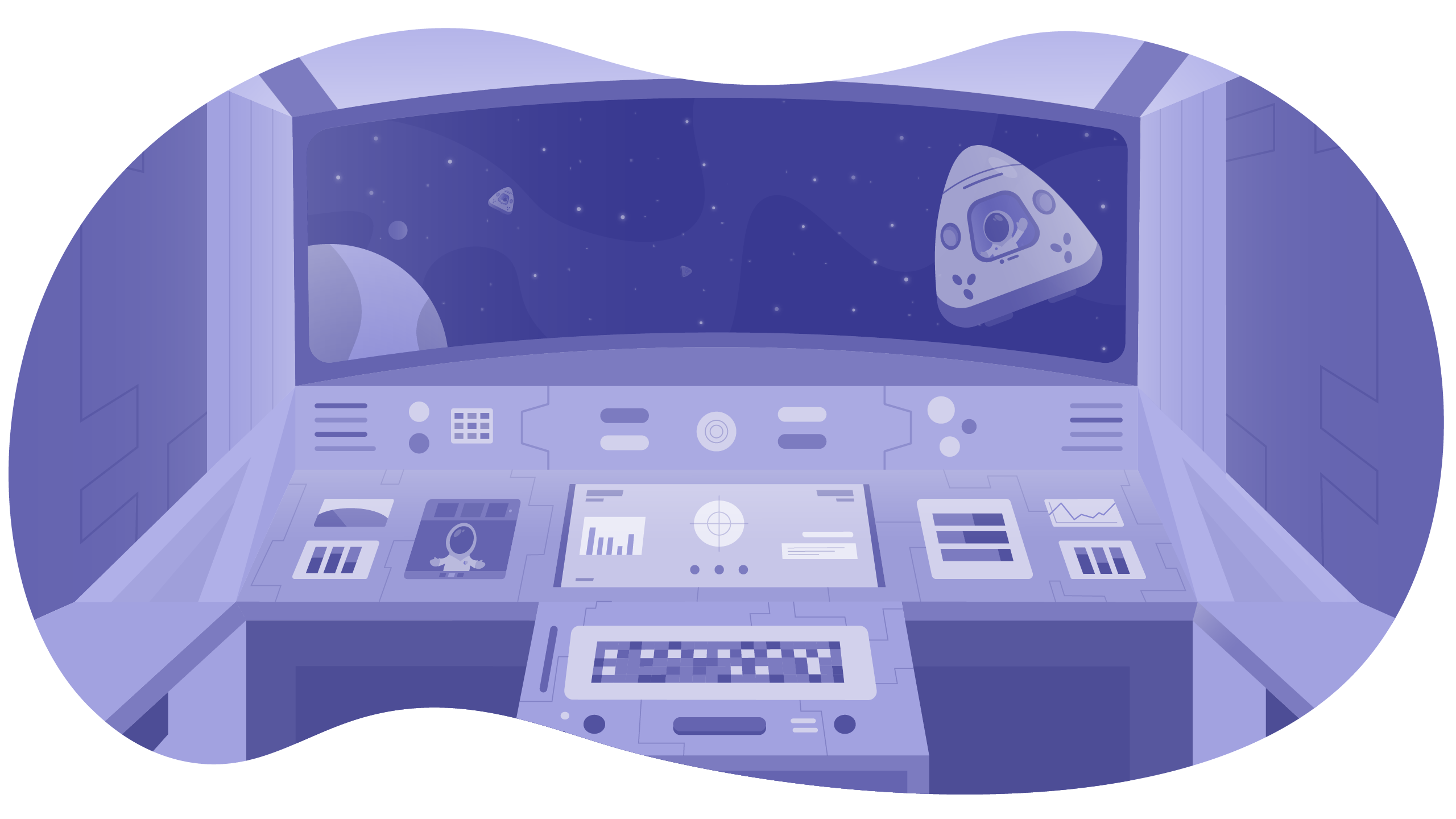
If you were running a business that was not oriented to remote work, it has been completely turned upside down. Even if you were “remote-only”, it is likely going to be tough sledding for the foreseeable future given the resulting economic downturn. However, relatively speaking, if you are a SaaS or software company and are not primarily servicing a vertical that has been directly affected, like travel or restaurants, you could be in a position to weather the storm and come out of it in a position of strength. You probably don’t have physical supply lines that are being affected. You should have limited fixed costs and reasonable costs of goods sold (COGS).
Yes, things are hectic and there is much uncertainty, but here are a few thoughts and resources about managing your SaaS business and perhaps even thriving in the upside down.
Note: This post assumes a typical SaaS company that has broad industry diversification across their customer base. There are obviously more dire circumstances for those that have higher concentrations in directly affected industries and those that are actually well positioned by solving problems exacerbated by our current situation.
Managing Expectations
We are in times of unprecedented uncertainty. I have heard prognostications across the spectrum from a deep recession and quick recovery to multi-year depression. What is clear is that no one knows what is going to happen and $2 trillion stimulus packages don’t happen when things are good.
The senior leaders of a startup do not have any great insight into what is going to happen to the economy. But they do have more knowledge than the rest of the employees about the financial state of their company. Imagine the level of uncertainty of an employee who doesn’t know how much money is in the bank. Their main concern might be whether or not payroll is going to happen next week. Now is the time to be completely forthright with employees about the situation and what the plan of action is. It is time to increase communication dramatically.
After it really hit the fan during the week of March 9th, our senior leaders got together to create a set of assumptions that we could present to the company. The first assumption is that there is no more outside investment, ever. That may sound dramatic but any other assumption on when that might happen would be completely arbitrary. It is time to start figuring out how to get to "Default Alive" as Paul Graham puts it.
In order to set expectations with employees, we modeled and presented three scenarios.
First, we decided to model the lower boundary, called “Worst case and we are stupid”. This was if we experienced 100% customer churn tomorrow, no new revenue ever, and we decide to continue with our hiring and budget plans (the stupid part). We were lucky enough to recently raise a Series A, so even this scenario was in line with what normally would be recommended runway. But these are not normal times.
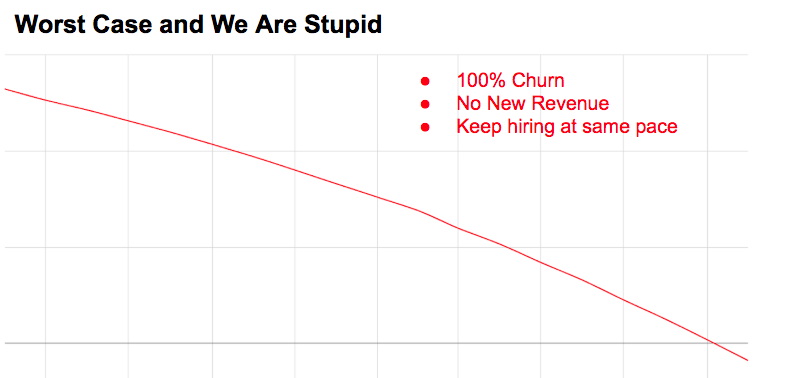

Next, we made the assumption that we are not stupid and that we should be freezing all new hiring and expenses until we have better visibility into what the future holds. This allowed us to double our runway but, of course, we were still not going to reach profitability (aka, “default alive”) given the assumption of zero new revenue.
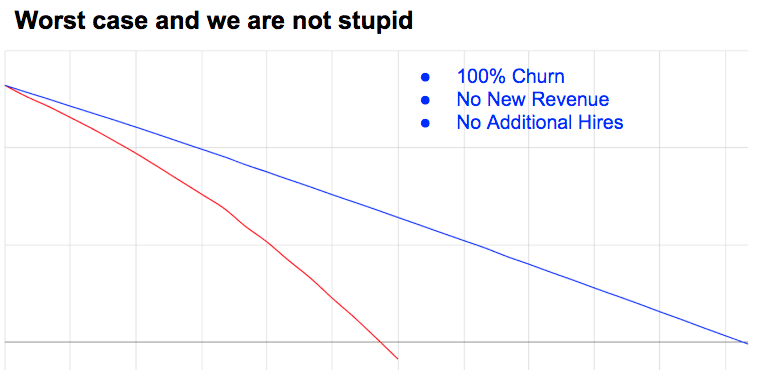

These scenarios basically gave us our glide path, so we know how much time we have before we need one of our engines to kick back in.
Finally, we modeled a scenario where 2020 is a horrible, terrible, no good year, but there are signs of recovery in 2021, gradual recovery in 2022, and things return back to normal in 2023. These assumptions are pretty arbitrary but the point is to have a fairly conservative "default alive" scenario that you are constantly measuring and iterating on as you get additional data.
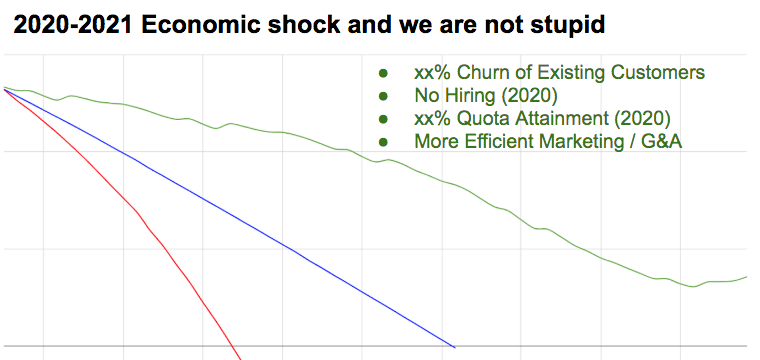

This presentation helped orientate employees to where we were and alleviated some of their immediate fears. The emphasis was to be conservative until we have more visibility and communicate with the team when things change.
Managing Supply Lines (People’s Brains)
Lucky for us, we don’t have physical supply lines from around the world that are getting disrupted. However, we do have supply lines - people’s brains. And right now those brains are in cognitive overload with things other than shipping or selling software or launching marketing campaigns. Not only that, but the physical work environments are different. Different equipment, different distractions.
The obvious primary focus is on people’s physical and mental health. People are going to need time to adjust to both the physical and mental changes that occur with a different way of life and work environment. The extroverts that thrived in a collaborative office environment may now be struggling at home and introverts doing deep work like programming, illustrating, or writing may be thriving at home (assuming they have a decent environment to do work).
Again, overcommunication is a good strategy here.
- Make sure 1x1s are happening.
- Encourage HR to reach out to employees.
- Do not make any assumptions that people know what is in your head.
- Be proactive about providing mental health resources.
- Encourage Q&A sessions with management.
All of this may help, but it’s unlikely that anyone will be performing at work as they usually would. That is why many companies (including us) have suspended performance reviews. For one, those are usually tied to promotions and raises which are likely frozen, but also, it’s not reasonable to assume normal performance right now.
If you read the resources below (that have remote-only biases), they will tell you how a remote company can be much more productive. However, a company in transition will mostly likely see a near term reduction in productivity, even in a normal environment. This reduction will be compounded by the stresses of the day-to-day environment outside of work.
Changing habits
Like most SaaS companies, we have remote workers, so we are familiar with the typical tooling and have relationships with the vendors used to facilitate this type of work. It was relatively easy to expand contracts, get new seats, etc. (If you are primarily co-located, you can review some of the resources below for more information on ramping up that tooling.)
The tooling is the easy part. The hard part is changing behavior. We have been relatively lucky in that we have always tried to accommodate remote work by encouraging our co-located employees to use the same types of communication that remote workers are required to use. That is why one of our company values is “We Write It Down”. Writing things down not only allows for easier sharing of information, it encourages a more thoughtful presentation of ideas. It helps when onboarding new employees - less knowledge is locked in people’s heads.
Even so, we were guilty of hallway conversations and holding meetings without proper notes. It has been a transition now that those things are not an option but we think it will instill better discipline in these areas.
Many people’s first reaction in this new environment will be to try to replace physical interactions with other close-to-synchronous communication channels, like Slack. This is actually not the best strategy - you get the worst of both worlds, constant interruptions without the benefits of physical interaction. We have been trying to encourage the reduction of Slack usage rather than increase it. Instead, we are trying to lean into the new environment by encouraging more deep work...things like using more written proposals, design docs, and the use of prepared itineraries that participants can review before meetings.
On the flip side, we also take breaks from work as a group. With a company "watercooler Zoom", video happy hours, and CS:GO tournaments, we are making a significant effort to make sure those who need that social interaction have the opportunity.
We are hopeful that the muscles we train during this WFH time will lead to more productive work even as we get back to the office.
Teleport cybersecurity blog posts and tech news
Every other week we'll send a newsletter with the latest cybersecurity news and Teleport updates.
Rethinking your product roadmap and positioning
Some products, like Zoom and Slack, were well positioned to take advantage of this new remote working environment. Most will need to make some adjustments to their product, positioning, and go to market strategy. In a future blog post, we’ll go into some of the things we have been evaluating and the adjustments we have made. Feel free to sign up to our newsletter below for an update when that post gets published.
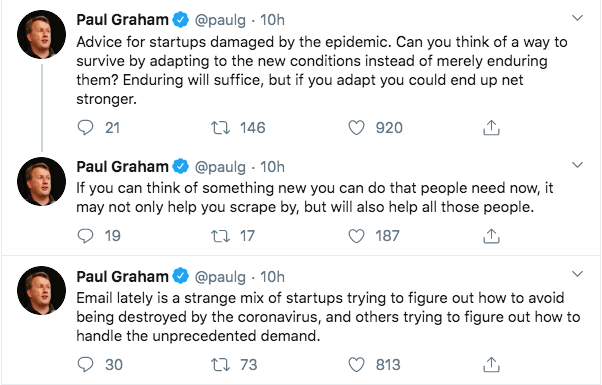

Resources and Conclusion
Hopefully some of this was helpful. This has obviously been a very difficult time. We feel incredibly fortunate to be relatively well positioned to survive this and in an industry that is not directly affected. We wish everyone out there the strength to get through this in the best way possible. This too, shall pass.
We have been reading up on materials on remote work. Here are some resources we’ve found helpful:
- REMOTE: Office Not Required - Bestselling book from the team at Basecamp shows employers and employees how they can work together, remotely, from any desk, in any place, anytime, anywhere.
- The Ultimate Guide to Remote Work - Free online resource by Zapier.
- Gitlab’s Guide to All-Remote - Free online resource by Gitlab.
- Gitlab’s Handbook - Free online resource by Gitlab (also a great resource in general)
- OMG I'm working remotely, now what?! This blog post by Benedikt Lehnert, Director of Product Design for Microsoft’s Mobile Experiences, compiles best practices and tips to keep you focused and boost your productivity while working from home.
- Why Great Teams Embrace Remote Work: This downloadable guide from the good people at Trello compiles tried and tested strategies from the world's leading remote companies.
- MiroBlog | A blog by Miro: Rather than any one post, Miro’s entire publication is dedicated to the future of distributed teamwork and includes specific insights on product development, agile management and experience design.
- 5 tips for ramping up on remote work in a hurry: Post from Atlassian’s “Work Life” blog.
- Working across land and sea: Tips for remote communication: This post on the “Inside Intercom” blog focuses on effective remote communication to ensure positive working relationships.
- Working from Home — a Guide: Charles Patterson, Senior designer and editor of InVision’s “Inside Design,” relays the lessons he’s learned over five years of working remotely.
- How to lead a distributed team: Jennifer Dennard, Co-Founder of Range, offers four tips for managers whose teams are suddenly split across two or more locations.
- Working Remotely: Tips from 100+ Remote Workers & Leaders: Help Scout has been writing about and advocating for remote work for a long time, and this resource compiles all of those learnings throughout the years.
- The software you need to lead a distributed engineering team: Cathy Reisenwitz outlines what to consider when adopting software for distributed engineering teams — the categories of software distributed engineering teams find helpful, which features to look for, and questions to keep in mind as you consider your options.
- Remotely Managing: This Medium publication is the brainchild of Stella Garber, the head of Trello’s distributed marketing team. She shares remote work insights from a management as well as individual standpoint.
- What’s Your Company’s Emergency Remote-Work Plan? This HBR piece outlines five steps business leaders can take “to not only flexibly respond to this potential disruption, but also to use it as an opportunity to reimagine work broadly.”
Tags
Teleport Newsletter
Stay up-to-date with the newest Teleport releases by subscribing to our monthly updates.

Subscribe to our newsletter

